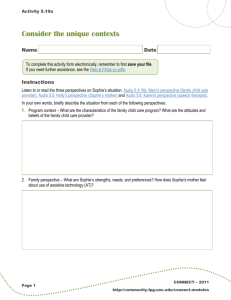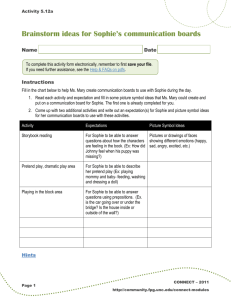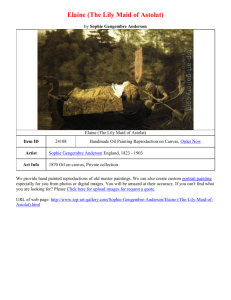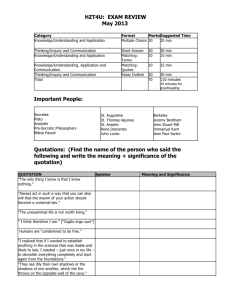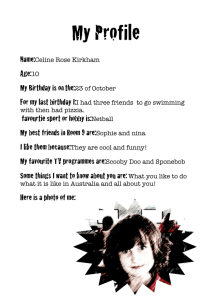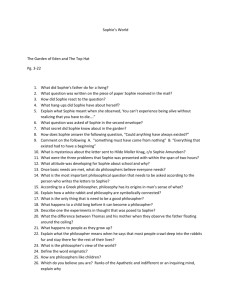Rdg 5840
advertisement
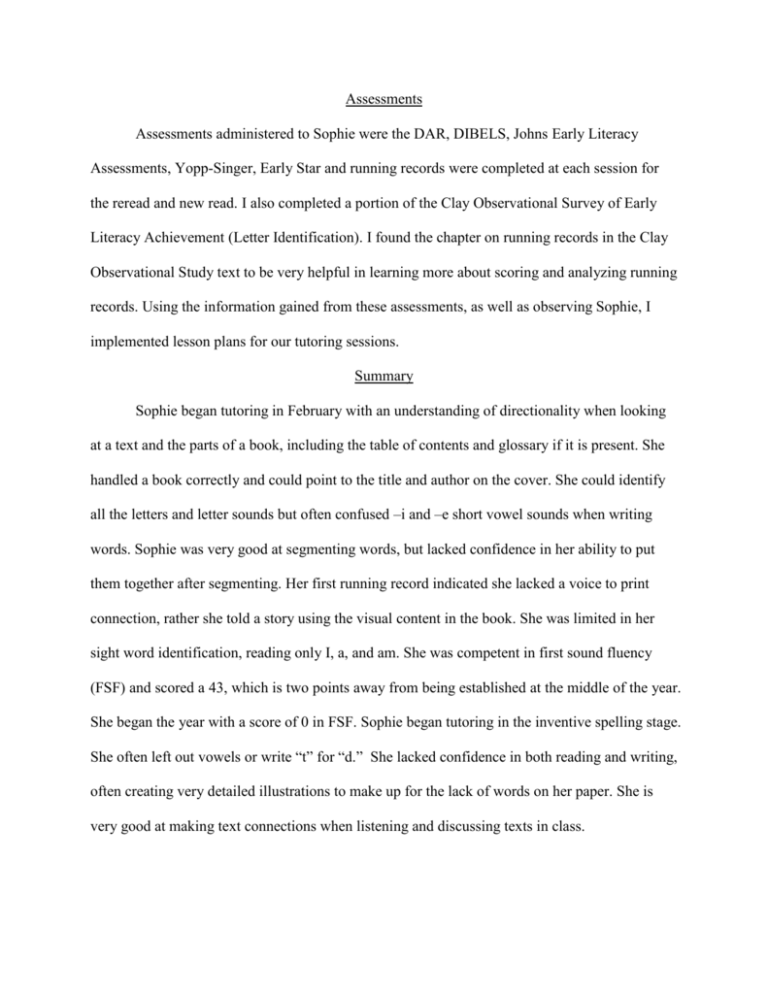
Assessments Assessments administered to Sophie were the DAR, DIBELS, Johns Early Literacy Assessments, Yopp-Singer, Early Star and running records were completed at each session for the reread and new read. I also completed a portion of the Clay Observational Survey of Early Literacy Achievement (Letter Identification). I found the chapter on running records in the Clay Observational Study text to be very helpful in learning more about scoring and analyzing running records. Using the information gained from these assessments, as well as observing Sophie, I implemented lesson plans for our tutoring sessions. Summary Sophie began tutoring in February with an understanding of directionality when looking at a text and the parts of a book, including the table of contents and glossary if it is present. She handled a book correctly and could point to the title and author on the cover. She could identify all the letters and letter sounds but often confused –i and –e short vowel sounds when writing words. Sophie was very good at segmenting words, but lacked confidence in her ability to put them together after segmenting. Her first running record indicated she lacked a voice to print connection, rather she told a story using the visual content in the book. She was limited in her sight word identification, reading only I, a, and am. She was competent in first sound fluency (FSF) and scored a 43, which is two points away from being established at the middle of the year. She began the year with a score of 0 in FSF. Sophie began tutoring in the inventive spelling stage. She often left out vowels or write “t” for “d.” She lacked confidence in both reading and writing, often creating very detailed illustrations to make up for the lack of words on her paper. She is very good at making text connections when listening and discussing texts in class. I administered multiple assessments prior to tutoring. The DAR results reflected what I was observing. Sophie did not master the print awareness checklist due to her lack of understanding where a sentence ends and matching print word length to the length of the spoken word. Sophie scored very high on the Literacy Knowledge assessment by Johns, missing only those questions relating to her ability to frame a sentence. She can identify a period and exclamation mark, but does not stop when reading. The information obtained from the Clay Observational Study indicated the same results. With this knowledge I began lessons teaching her to point to each word and stop when she saw ending punctuation. Sophie did very well on the Johns wordless picture reading. She can create a wonderful story using visual clues. This was evident in her first running record as well. Understanding that Sophie uses mostly visual cues when reading will be important information when choosing a text. Sophie sounded out the words cat, pat, big, and pets when reading The Cat from the Johns book. When reading The Red Hen she continued sounding out words red, hen, sat, get, did, and had. I read both passages to Sophie so she could answer the comprehension questions. Comprehension is a strength of Sophies. Sophie sounded out four of the ten words from the Basic Word Knowledge list in the Johns book. She could only read “a” with automaticity. Since there are many sight words in the Johns’ passages and word list, our sessions will include focusing on learning sight words and reading them with automaticity. Sophie mastered all levels of phonological awareness on the DAR, which also was indicative of what Sophie’s DIBELS scores implied. Sophie’s middle of the year DIBELS score for phoneme segmentation was 60, which is established. I also used the Yopp-Singer assessment and Sophie scored a 22/22. Knowing Sophie mastered segmentation would allow me to use this skill as a reading strategy for unknown words. When Sophie would come across an unknown word, she learned to ask herself, “What do I know about this word?” to help her decode. She used her knowledge of initial sounds and segmenting the words to help her. As the tutoring progressed, Sophie was able to look at words and find sight words within words and look at blends and suffixes instead of sounding out every letter. Continuing to use this strategy will help Sophie become a more confident, successful reader. Sophie also mastered letters and sounds on the DAR, which complemented the results of the Johns Early Literacy Assessment of alphabetic knowledge and the Letter Identification portion of the Clay Observational Study. Sophie scored 26/26 on both upper and lower case letter naming for the Johns and 54 on the Clay. In regards to her DIBELS score for letter naming fluency, Sophie ranked in the far below category at the middle of the year. While she can name the letters, naming them quickly was not an area of strength for her. She ended the year with a 60, which is emerging. Not naming them at a rate of 89 letters per minute (established at end of year) does not seem to impede her ability to decode words. In regards to the Clay Study, Sophie did well giving words with the initial sound of a letter I indicated to her. Understanding this information will allow us to move from any work with letter naming to using what she knows to decode words. Sophie’s Early Star scaled score increased from the beginning of the year and by March her score indicated she was a late emergent reader. There is a problem with the program and students have not been able to complete end of year testing, but once it is running I feel confident Sophie’s score will indicate she has progressed to a transitional reader. Conclusion and Recommendations Throughout the twenty-five tutoring sessions, Sophie made gains in sight word recognition, reading more than 50% of her words with automaticity and recognizing 70% of the words in print. This is a huge gain from only reading three words when we began. She has begun to cross check for information and is relying less on visual cues when reading. One example of this was when asked how she knew the word was hen and not chicken. She replied that the word began with “h” and chicken began with “ch.” The same was true for horse when she was asked why the word was not pony since the picture looked like a pony. She replied that pony begins with “p” and horse begins with “h.” Using what she knows about a word has been one of the most meaningful strategies for her. She will ask herself this as she reads and gets stuck on a word. She will also ask herself after reading and making an error, “Did that make sense?” She has begun to self-correct more as she reads. She is very bright in regards to comprehension. She regularly scores high on her accelerated reader quizzes and has taken 57 quizzes since October and passed 55 of them with few scores lower than a 4/5. Her writing has improved drastically since the start of the year. When Sophie arrived in kindergarten she could not write her name. She quickly caught on to forming letters, but they had no meaning to her. Now Sophie eagerly participates in our daily classroom free write. Writing was one of the things she enjoyed about tutoring and the more sight words she was able to read/recognize, the better her writing became. She was consistent throughout tutoring with always beginning a sentence with an upper case letter and using ending punctuation. Spacing was also good and most letters are formed appropriately. As Sophie is promoted to first grade there are several recommendations I would make. First, Sophie needs to continue to feel successful when reading. She needs to be reminded that good beginning readers point to the words and know when to stop. As Sophie gains confidence in reading, she will need to read text that has more meaning and less visual cues for her to rely on. Since she relies heavily on visual cues, structure and meaning can be an after thought. She will need to use the strategies that will help her make meaning of a text, using both structure and meaning cues. Continued practice with sight words will be important, but alternative ways of learning them instead of using flash cards alone should be implemented. I am recommending that Sophie be put in a general education classroom and be pulled out for Title 1 services. Being a part of a small group and hearing what fluent readers sound like will be helpful to her. Sophie will also need some work with syllables. While she can segment words very well, the DAR indicated she had little understanding of syllables. Sophie has begun to read with expression and accurately. She will need to continue to practice reading fluently.
